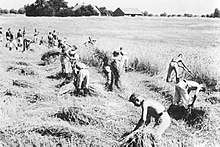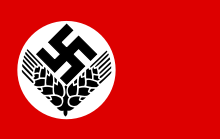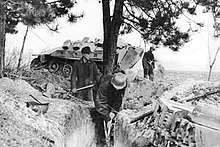Reich Labour Service
| Reichsarbeitsdienst - RAD | |
|
House flag with RAD symbol | |
 A RAD squad in 1940 | |
| Agency overview | |
|---|---|
| Formed | 26 June 1935 |
| Preceding agencies |
|
| Dissolved | 8 May 1945 |
| Type | Labor Army |
| Jurisdiction |
Occupied Europe |
| Headquarters |
Berlin–Grunewald 52°29′31″N 13°17′6″E / 52.49194°N 13.28500°E |
| Employees |
200,000 (1935) 350,000 (October 1939) |
| Agency executive | |
| Parent agency | |
The Reich Labour Service (Reichsarbeitsdienst; RAD) was a major organisation established in Nazi Germany as an agency to help mitigate the effects of unemployment on the German economy, militarise the workforce and indoctrinate it with Nazi ideology. It was the official state labour service, divided into separate sections for men and women.
From June 1935 onward, men aged between 18 and 25 had to serve six months before their military service. During World War II compulsory service also included young women and the RAD developed to an auxiliary formation which provided support for the Wehrmacht armed forces.

Foundation
In the course of the Great Depression, the German government of the Weimar Republic under Chancellor Heinrich Brüning by emergency decree had established the Freiwilliger Arbeitsdienst ('Voluntary Labour Service', FAD) on 5 June 1931, two years before the Nazi Party (NSDAP) ascended to national power. The state sponsored employment organisation provided services to civic and land improvement projects, from 16 July 1932 it was headed by Friedrich Syrup in the official rank of a Reichskommissar. The idea of a national compulsory service was quite popular, especially in right-wing circles, but it had little effect on the economic situation.
The concept was adopted by Adolf Hitler, who upon the Nazi seizure of power in 1933 appointed Konstantin Hierl state secretary in the Reich Ministry of Labour, responsible for FAD matters. Hierl was already a high-ranking member of the NSDAP and head of the party's labour organization, the Nationalsozialistischer Arbeitsdienst or NSAD. Hierl developed the concept of a state labour service organisation similar to the Reichswehr army, with a view to implementing a compulsory service. Meant as an evasion of the regulations set by the 1919 Treaty of Versailles, voluntariness initially was maintained after protests by the Geneva World Disarmament Conference.
Hierl's rivalry with Labour Minister Franz Seldte led to the affiliation of his office as a FAD Reichskommissar with the Interior Ministry under his party fellow Wilhelm Frick. On 11 July 1934, the NSAD was renamed Reichsarbeitsdienst or RAD with Hierl as its director until the end of World War II. By law issued on 26 June 1935, the RAD was re-established as an amalgamation of the many prior labour organisations formed in Germany during the Weimar Republic,[2] with Hierl appointed as Reich Labour Leader (Reichsarbeitsführer) according to the Führerprinzip. With massive financial support by the German government, RAD members were to provide service for mainly military and to a lesser extent civic and agricultural construction projects.
Organization

The RAD was divided into two major sections, one for men (Reichsarbeitsdienst Männer - RAD/M) and the voluntary, from 1939 compulsory, section for women (Reichsarbeitsdienst der weiblichen Jugend - RAD/wJ).
The RAD was composed of 33 districts each called an Arbeitsgau (lit. Work District) similar to the Gaue subdivisions of the Nazi Party. Each of these districts was headed by an Arbeitsgauführer officer with headquarters staff and a Wachkompanie (Guard Company). Under each district were between six and eight Arbeitsgruppen (Work Groups), battalion-sized formations of 1200–1800 men. These groups were divided into six company-sized RAD-Abteilung units.
Conscripted personnel had to move into labour barracks. Each rank and file RAD man was supplied with a spade and a bicycle. A paramilitary uniform was implemented in 1934; beside the swastika brassard, the RAD symbol, an arm badge in the shape of an upward pointing shovel blade, was displayed on the upper left shoulder of all uniforms and great-coats worn by all personnel. Men and women had to work up to 76 hours a week.
War
The RAD was classed as Wehrmachtgefolge (lit. Defence Force Following). Auxiliary forces with this status, while not a part of the Armed Forces themselves, provided such vital support that they were given protection by the Geneva Convention. Some, including the RAD, were militarised.
Just prior to the outbreak of World War II, nearly all the RAD/M's extant RAD-Abteilung units were either incorporated into the Heer's Bautruppen (Construction troops) as an expedient to rapidly increase their numbers or else in a few cases transferred to the Luftwaffe to form the basis of new wartime construction units for that service. New units were quickly formed to replace them.
During the early war Norwegian and Western campaigns, hundreds of RAD units were engaged in supplying frontline troops with food and ammunition, repairing damaged roads and constructing and repairing airstrips. Throughout the course of the war, the RAD were involved in many projects.[3] The RAD units constructed coastal fortifications (many RAD men worked on the Atlantic Wall), laid minefields, manned fortifications, and even helped guard vital locations and prisoners.

The role of the RAD was not limited to combat support functions. Hundreds of RAD units received training as anti-aircraft units and were deployed as RAD Flak Batteries.[3] Several RAD units also performed combat on the eastern front as infantry. As the German defences were devastated, more and more RAD men were committed to combat. During the final months of the war RAD men formed 6 major frontline units, which were involved with serious fighting. On the western front RAD troops were used as reinforcements to the 9th SS Engineer Abt (SS-Captain Moeller) in the fighting to retake the northern end of the Arnhem bridge from British Paratroopers under Col. Frost. This action was during Operation Market-Garden in September 1944. It was noted that the RAD troops had no combat experience. SS-Captain Moeller's report concluded: "These men were rather sceptical and reluctant at the beginning, which was hardly surprising. But when they were put in the right place they helped us a lot; and in time they integrated completely, becoming good and reliable comrades." Losses for these troops were in the hundreds.[4]
Ranks and insignia
Ranks
| Troop Ranks[5] | Administrative Ranks[5] | Medical Officers Ranks[5] | Female Ranks | Equivalent rank in the Wehrmacht[6] |
|---|---|---|---|---|
| Arbeitsmann | - | - | Arbeitsmaid | Schütze |
| Vormann | - | - | - | Gefreiter |
| Obervormann | - | - | - | Obergefreiter |
| Hauptvormann | - | - | - | Stabsgefreiter |
| Untertruppführer | - | - | - | Unteroffiziersanwärter |
| Truppführer | Truppführer | - | Kameradschaftsälteste | Unteroffizier |
| Obertruppführer | Obertruppführer | - | Jungführerin | Feldwebel |
| Haupttruppführer introduced 1944 | - | - | - | Oberfeldwebel |
| Unterfeldmeister | Unterfeldmeister | - | Maidenunterführerin | Oberfähnrich |
| Feldmeister | Amtswalter | - | Maidenführerin | Leutnant |
| Oberfeldmeister | Oberamtswalter | Arbeitslagerarzt | Maidenoberführerin | Oberleutnant |
| Oberstfeldmeister | Hauptamtswalter | Arbeitsfeldarzt | Maidenhauptführerin | Hauptmann |
| Arbeitsführer | Stabsamtswalter | Arbeitsarzt | Stabsführerin | Major |
| Oberarbeitsführer | Oberstabsamtswalter | Oberarbeitsarzt | Stabsoberführerin | Oberstleutnant |
| Oberstarbeitsführer | Oberstamtswalter | Oberstarbeitsarzt | Stabshauptführerin | Oberst |
| Generalarbeitsführer | Generalarbeitsführer | Generalarbeitsarzt | - | Generalmajor |
| Obergeneralarbeitsführer | - | - | - | Generalleutnant |
| Generalfeldmeister introduced 1945, never awarded | - | - | - | General |
| Generaloberstfeldmeister introduced 1945 | - | - | - | Generaloberst |
| Reichsarbeitsführer | - | - | - | Generalfeldmarschall |
Rank insignia 1943-1944
- 1 Reichsarbeitsführer
- 2 Obergeneralarbeitsführer
- 3 Generalarbeitsführer
- 4 Oberstarbeitsführer
- 5 Oberarbeitsführer
- 6 Arbeitsführer
- 7 Oberstfeldmeister
- 8 Oberfeldmeister
- 9 Feldmeister
- 10 Unterfeldmeister
- 11 Obertruppführer
- 12 Truppführer
- 13 Untertruppführer
- 14 Obervormann
- 15 Vormann
- 16 Arbeitsmann
Equipment
- Luger pistol
- Gewehr 98
- Stielhandgranate
- Model 39 grenade
- Schiessbecher
- Panzerfaust
- Sturmpistole
- Panzerbüchse 39
- MP 3008
- Einstossflammenwerfer 46
- MG 08
- Schwarzlose machine gun
- Teller mine
- S-mine
- Stock mine
- Schu-mine 42
- Glasmine 43
- Abwehrflammenwerfer 42
- Topfmine
- Riegel mine 43
- 2 cm Flak 30/38/Flakvierling
- Volkswagen Kübelwagen
- Opel Blitz
- Mercedes-Benz L3000
- Krupp Protze
- SdKfz 2
- M42 Truppenfahrrad
See also
Notes
- ↑ Nominally.
- ↑ Hartmut Heyck, "Labour Services in the Weimar Republic and their Ideological Godparents", Journal of Contemporary History, 2003; 38: 221-236
- 1 2 McNab 2009, p. 55.
- ↑ Moeller 'Die Schlacht um Arnheim-Oosterbeek. Der Einsatz des Pionier Battalion 9 Hohenstaufen vom 17. bis 26. September 1944.
- 1 2 3 Michael Hansen, "Idealisten" und "gescheiterte Existenzen". Das Führerkorps des Reichsarbeitsdienstes'', Diss. Universität Trier 2004, pp. 141-142.
- ↑ Hansen 2004, pp. 139, 175
References
- Kiran Klaus Patel: Soldaten der Arbeit. Arbeitsdienste in Deutschland und den USA, 1933-1945, Verlag Vandenhoeck & Ruprecht, Göttingen 2003. ISBN 3-525-35138-0.
English edition: "Soldiers of Labor. Labor Service in Nazi Germany and New Deal America", 1933–1945, Cambridge University Press, New York 2005, ISBN 0-521-83416-3. - McNab, Chris (2009). The Third Reich. Amber Books. ISBN 978-1-906626-51-8.
External links
 Media related to Reich Labour Service at Wikimedia Commons
Media related to Reich Labour Service at Wikimedia Commons- The German Reichsarbeitsdienst

